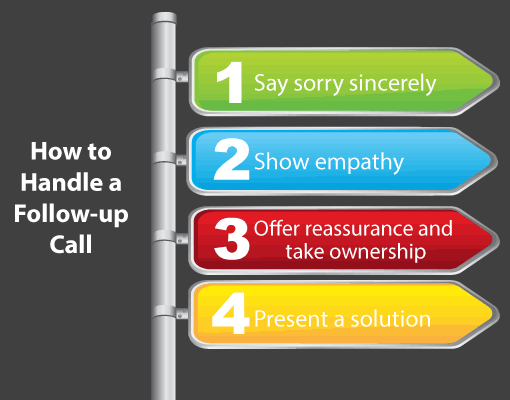Responding well to a low satisfaction score or a customer complaint is an important retention tool, but very few companies are expert in doing so.
To retain an unhappy customer, you need to solve their problem and blow their socks off. This is much easier said than done, but here are some useful pointers to help you on your way.
First Assess the Context Behind the Complaint
When you receive a complaint, the temptation is to pick up the phone and try to solve the issue right away. Yet you can do this much more effectively if you understand the context of the complaint first.
Also, you want to give the customer a little time to cool off, so they do not talk to you from an overly negative standpoint. By this, we don’t mean a couple of hours or longer, so that the customer believes that you’re not taking their complaint seriously, but enough time for you to investigate what went wrong.
If you rush to the phone without knowing what the customer has complained about, you will not be able to offer a genuine apology, which is an obvious first step in responding to a disappointed customer. Remember, it is important to avoid making throw-away apologies because the customer is “always right”. That will not blow their socks off.

Christopher Brooks
So, Christopher Brooks, a Customer Excellence Consultant at Enzen Group, suggests that you consider: “Is this the first time this customer has complained? Is this a follow-up complaint? Is the complaint a deflection of another issue? Knowing this will demonstrate to the customer that you’ve done your research and that you are taking their complaint seriously.”
Once you understand the context, then you can follow up by saying sorry sincerely, showing empathy, offering reassurance and taking responsibility to finding a solution during a follow-up contact.
For more advice on saying sorry sincerely, visit: 16 Apology Statements for Customer Service
Which Channel Is Best for the Follow-Up Contact?
While we can all agree that the best response is to follow up with the customer soon after their complaint or low customer satisfaction score was registered, how do we decide which is the most appropriate channel to follow up on?
Most would argue that the telephone is the best channel, to ensure the customer hears your apology and can sense empathy through the tone of your voice. Yet there are those who believe that the best thing to do is to stick to the customer’s channel of choice.
However, Christopher Brooks believes that the options should be less “black or white” and that the customer’s contact history should give you all the information you need.
Christopher says: “Your systems should tell you about the contact patterns of each of your customers, not just their preferred channel, but which channel they have used to discuss certain issues in the past.”
Your systems should tell you about the contact patterns of each of your customers, not just their preferred channel, but which channel they have used to discuss certain issues in the past.
Christopher Brooks
“If they have picked up the phone on at least one occasion before, it might be worth a phone call, as that is the best channel for showing empathy. But if they have avoided the phone at all costs, preferences may come into play.”
So, the follow-up phone call is ordinarily the best option to “air everything out”, but if the customer shows signs of an aversion to the phone, other options may be better.
The Follow-Up Call
We now understand the context and the advisor channel preference, so it is time to make contact. As alluded to earlier, here are the four stages of the follow-up.
Step 1: Say sorry sincerely – Reflect back on what the customer said in the complaint to make it clear what you’re apologising for and to sound authentic. This is a vital first step.

Frank Sherlock
As Frank Sherlock, VP International at CallMiner, says: “Our research shows that apologies get better responses than financial compensation. Double the number of people who had posted a negative comment about a service (45%) withdrew it when they received an apology than those who were offered financial compensation to remove it (23%).”
Step 2: Show empathy – Warmth is key, there is great value in human empathy. Much of the time, customers just want to know that they have been heard and understood.
Step 3: Offer reassurance and take ownership – Give the customer peace of mind by taking the issue out of their hands. Try to use compassionate and attentive language and reassuring noises to help with this.
Step 4: Present a solution – You’ve taken the time to understand context and the customer’s preferences, meaning that you can now offer a solution.

Remember to involve the customer when discussing a solution. While you may have an idea of what’s best before you make contact with them, ask them if they agree that this solution is best for them and get them invested in it.
Use the context, other customer information and what they tell you during the follow-up call as reasoning for why you believe your suggested solution is best for them. Get the customer’s consent to go ahead with your solution, but refer to it as “our solution” to signal that it is a team effort.
Then Comes the Case Management
As it is a team effort, it is important to be proactive in updating the customer on what you are doing to handle their complaint, after the follow-up call, according to Christopher Brooks.
As Christopher says: “Too often, organisations leave the customer in the dark when handling a complaint. They put all of their focus on finding a solution that they don’t ‘break-up’ the management process.”
The upset customer has both functional and emotional needs. While most contact centres do the functional response, they forget the human aspect.
Christopher Brooks
“If the customer has to wait a long time without an update, until a solution is found, they lose faith in your process and negative emotion starts to creep in.”
“Remember the upset customer has both functional and emotional needs. While most contact centres do the functional response, they forget the human aspect. This includes everything from showing real empathy to keeping the customer updated, to give them peace of mind.”
So, whenever you achieve a breakthrough in finding a solution, notify the customer via a quick SMS or email. Your response to a customer that you have let down should be both proactive and collaborative – these are the keys to doing what’s right for the customer.
Don’t Let Your Response Process Become Subjective
Whether it is a team leader or a specialist advisor that follows up with the customer, make sure they have all the tools necessary and a clear protocol to follow, Christopher Brooks advises.
Christopher says: “A lot of managers tell advisors to ‘go the extra mile’, but don’t make it clear what that means. This can confuse the team, as everyone has a different understanding of how far they can go to find a solution in the best interest of their customers.”
A lot of managers tell advisors to ‘go the extra mile’, but don’t make it clear what that means. This can confuse the team.
When it comes to complaints made after an outbound call, subjective guidelines, such as “go the extra mile” are even more of a challenge for advisors.
As Christopher adds: “If a customer makes a complaint about an outbound call, is another outbound call the best way to resolve the matter?”
“Protocols for how to respond to the customer and best practices for how to support different types of customers in different situations need to be made available, so that each customer receives the same level of support and advisors feel confident in servicing customers.”
So, implement a uniform policy to check for context, follow up and update the customer as you go. This can help to systemise the response process and provide greater guidance to advisors.
What to Do With Repeat Complaint Reasons
After we’ve found a solution and the customer is happy, we should take our time to investigate why the complaint occurred in the first place, right? Not necessarily, as Christopher Brooks tells us.
When we respond well to a customer complaint, we can create a positive that outweighs the negative.
Christopher says: “Sometimes, getting things wrong gives us opportunities for customer loyalty. When we respond well to a customer complaint, we can create a positive that outweighs the negative.”
“If you get to a point when your complaint process is so professional that you’re securing greater loyalty than if the customer experienced a smooth journey, there isn’t always great value in ironing out every little complaint.”
If we had time to combat every little mistake and add greater rewards to the customer journey, things might be different. But contact centres are usually time-pressured environments.
Christopher continues: “Of course, it’s different when it’s a complaint that impacts so many of your customers that advisors are juggling multiple cases at once. These are the complaint types that need to be ‘ironed out’.”
“So, when a complaint is made, advisors should register the complaint reason and a low CSat score call type. For the most common, you should test your customer journeys. Assess what can be done to prevent the contact coming into the contact centre in the first place.”
With this in mind, make sure you are prioritising the complaint types that cause the most unrest, but first things first, manage the response process and focus on turning negative experiences around.
In Summary
When a complaint first comes through, resist the temptation to immediately follow up with the customer. First, take some time to assess the wider context of the complaint and the customer’s contact patterns.
From these patterns, decide on the most appropriate method of following up with the customer – which will most likely be the phone, as this is the best channel to convey empathy.
During the follow-up, refer back to the complaint to make a sincere apology to the customer, acknowledge their issue and take ownership of it.
Then, offer a personalised solution and get the customer’s buy-in. Refer to the solution as “our solution” to create a feeling of teamwork.
Once the follow-up call is complete, work towards the solution and be proactive in updating the customer, which will again highlight your “team focus”.
Each of the stages, or whatever protocol you chose to implement, should be made clear to the team to avoid subjectivity in statements like “go the extra mile” and to fill them with confidence in handling each case.
But for troubling repeat complaint reasons, do more. Assess the customer journey and look to adapt the customer experience to avoid customer complaints and make life easier for yourselves in the contact centre.
For even more advice, trying reading some of the following articles:
- Really Understand Why Your Customers Are Contacting You
- 20 Great Ways to Drive Down Customer Complaints
- A Policy for Dealing with Angry and Abusive Customers
Author: Robyn Coppell
Published On: 23rd Jan 2019 - Last modified: 14th Aug 2025
Read more about - Customer Service Strategy, Angry Customers, CallMiner, Complaints, Customer Service, Handling Customers, Service Strategy









































